

List of mythologies. This is a list of mythologies of the world, by culture and region.
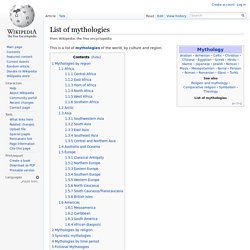
Mythologies by region[edit] Africa[edit] Central Africa[edit]
Arabian Mythology. Ars Goetia. Aztec Mythology. Celtic mythology. Overview[edit] Though the Celtic world at its apex covered much of western and central Europe, it was not politically unified nor was there any substantial central source of cultural influence or homogeneity; as a result, there was a great deal of variation in local practices of Celtic religion (although certain motifs, for example the god Lugh, appear to have diffused throughout the Celtic world).
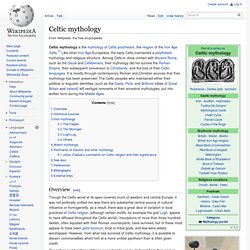
Inscriptions of more than three hundred deities, often equated with their Roman counterparts, have survived, but of these most appear to have been genii locorum, local or tribal gods, and few were widely worshipped. However, from what has survived of Celtic mythology, it is possible to discern commonalities which hint at a more unified pantheon than is often given credit. Celtic mythology is found in a number of distinct, if related, subgroups, largely corresponding to the branches of the Celtic languages:
Cthulhu Mythos. Egyptian Mythology. Greek/Roman Mythology. Haitian Voodoo. Inca mythology. Inca mythology includes many stories and legends that are mythological and to explain or symbolizes Inca beliefs.[1] All those that followed the Spanish conquest of the Inca Empire by Francisco Pizarro burned the records of the Inca culture.
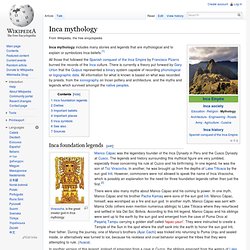
There is currently a theory put forward by Gary Urton that the Quipus represented a binary system capable of recording phonological or logographic data. All information for what is known is based on what was recorded by priests, from the iconography on Incan pottery and architecture, and the myths and legends which survived amongst the native peoples. Inca foundation legends[edit] Viracocha, is the great creator god in Inca mythology.
Indian Mythology - Hindu Mythology Articles, Facts @ Indian Divinity.com. Indian Mythology dates back to as early as 7200 B.C. when the first hymns of the RIG VEDA was composed.
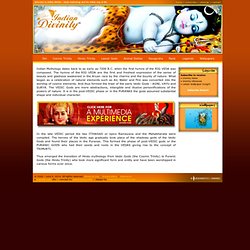
The hymns of the RIG VEDA are the first and freshest expression of the sense of beauty and gladness awakened in the Aryan race by the charms and the bounty of nature. What began as a celebration of natural elements such as Air, Water and Fire was converted into the worship of cosmic elements.
Japanese Mythology. Maya mythology. Maya mythology is part of Mesoamerican mythology and comprises all of the Maya tales in which personified forces of nature, deities, and the heroes interacting with these play the main roles.
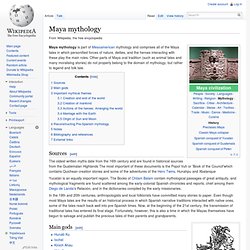
Other parts of Maya oral tradition (such as animal tales and many moralising stories) do not properly belong to the domain of mythology, but rather to legend and folk tale. Sources[edit] The oldest written myths date from the 16th century and are found in historical sources from the Guatemalan Highlands The most important of these documents is the Popol Vuh or 'Book of the Council'which contains Quichean creation stories and some of the adventures of the Hero Twins, Hunahpu and Xbalanque Yucatán is an equally important region. In the 19th and 20th centuries, anthropologists and local folklorists have committed many stories to paper.
Norse Mythology. Category:Persian mythology. Slavic Mythology. Scottish mythology. Scottish mythology may refer to any of the mythologies of Scotland.
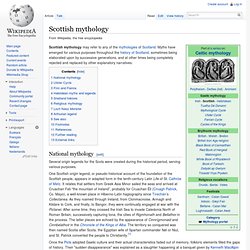
Myths have emerged for various purposes throughout the history of Scotland, sometimes being elaborated upon by successive generations, and at other times being completely rejected and replaced by other explanatory narratives. National mythology[edit] Several origin legends for the Scots were created during the historical period, serving various purposes.
Welsh mythology. The prose stories from the White and Red Books are known as the Mabinogion, a title given to them by their first translator, Lady Charlotte Guest, and also used by subsequent translators.
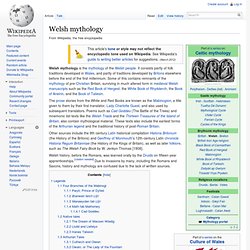
Poems such as Cad Goddeu (The Battle of the Trees) and mnemonic list-texts like the Welsh Triads and the Thirteen Treasures of the Island of Britain, also contain mythological material. These texts also include the earliest forms of the Arthurian legend and the traditional history of post-Roman Britain. Dungeon Dimensions - Discworld & Terry Pratchett Wiki. The Dungeon Dimensions are the great dark dimensions less than a shadow's width away.
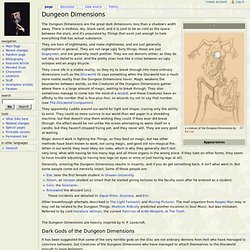
There is endless, dry, black sand, and it is said to be as cold as the space between the stars, and it's populated by Things that exist just enough to hate everything that has actual substance. They are born of nightmares, and make nightmares, and are just generally nightmarish in general. They are not large ugly furry things; those are just bogeymen, and are generally much prettier. They are not demons either, as they do not rely on belief to exist. And the pretty ones look like a cross between an ugly octopus and an angry bicycle.
Misc. Ref sites/other. Asase Ya. Asase Ya (or Asase Yaa, Asaase Afua[1]) is the Earth goddess of fertility[2] of the Ashanti people of Ghana.[3] She is the wife of Nyame the Sky deity, who created the universe.[4] She gave birth to the two children, Bea and Tano.
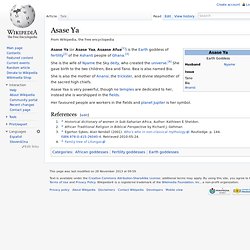
Bea is also named Bia. She is also the mother of Anansi, the trickster, and divine stepmother of the sacred high chiefs. Nyame. Nyame (or Nyambe, Nyankopon) is the Sky deity of the Akan people of Akanland (South Ghana), the leader of the Abosom, the Akan spirits and minor gods.[4] His name means "he who knows and sees everything" and "omniscient, omnipotent sky god" in the Akan language; and "he who does not speak" in the Luyana language.[5] Function[edit] He is called "omniscient, omnipotent sky god of the Akan people"; and he is called "king of the Lozi people" and it is said that he was a maker of animals, forests and birds.[6] Nyame is portrayed as a benevolent god, if sometime aloof and distant.
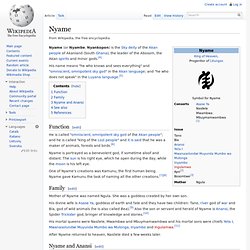
Lugbara mythology. The Lugbara live in the Democratic Republic of the Congo and Uganda. In Lugbara mythology, Adroa appeared in both good and evil aspects; he was the creator god and appeared on Earth as a human who was near death. He was depicted as a very tall white man with only one half of a body, missing one eye, one leg, etc. His children were called the Adroanzi. Odinani. Ọdinani, also Ọdinala, Omenala,Omenana, Odinana or Ọmenani is the traditional cultural beliefs and practices of the Igbo people[1] of Nigeria. These terms, as used here in the Igbo language, are synonymous with the traditional Igbo "religious system" which was not considered separate from the social norms of ancient or traditional Igbo societies.
Theocentric in nature, spirituality played a huge role in their everyday lives.